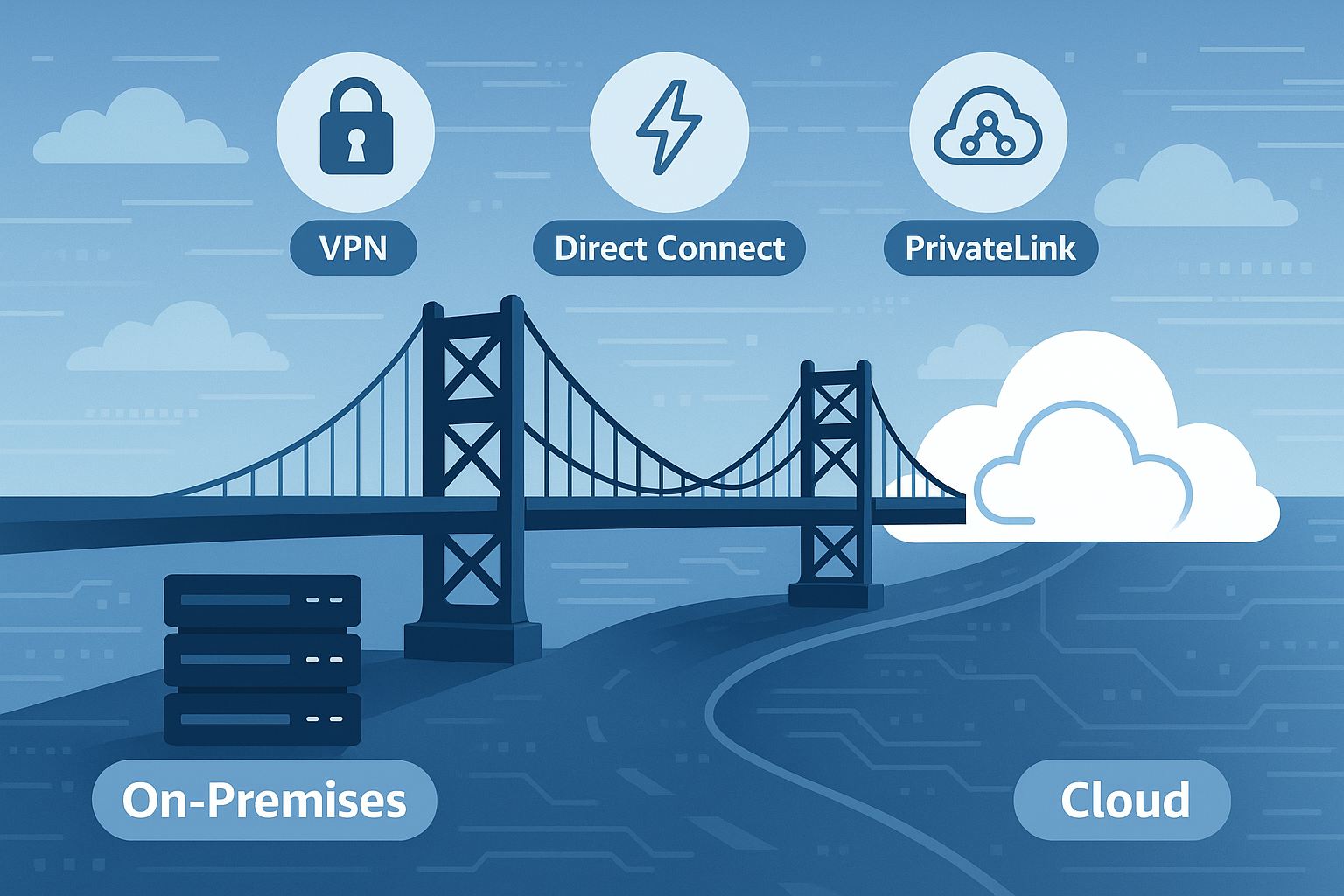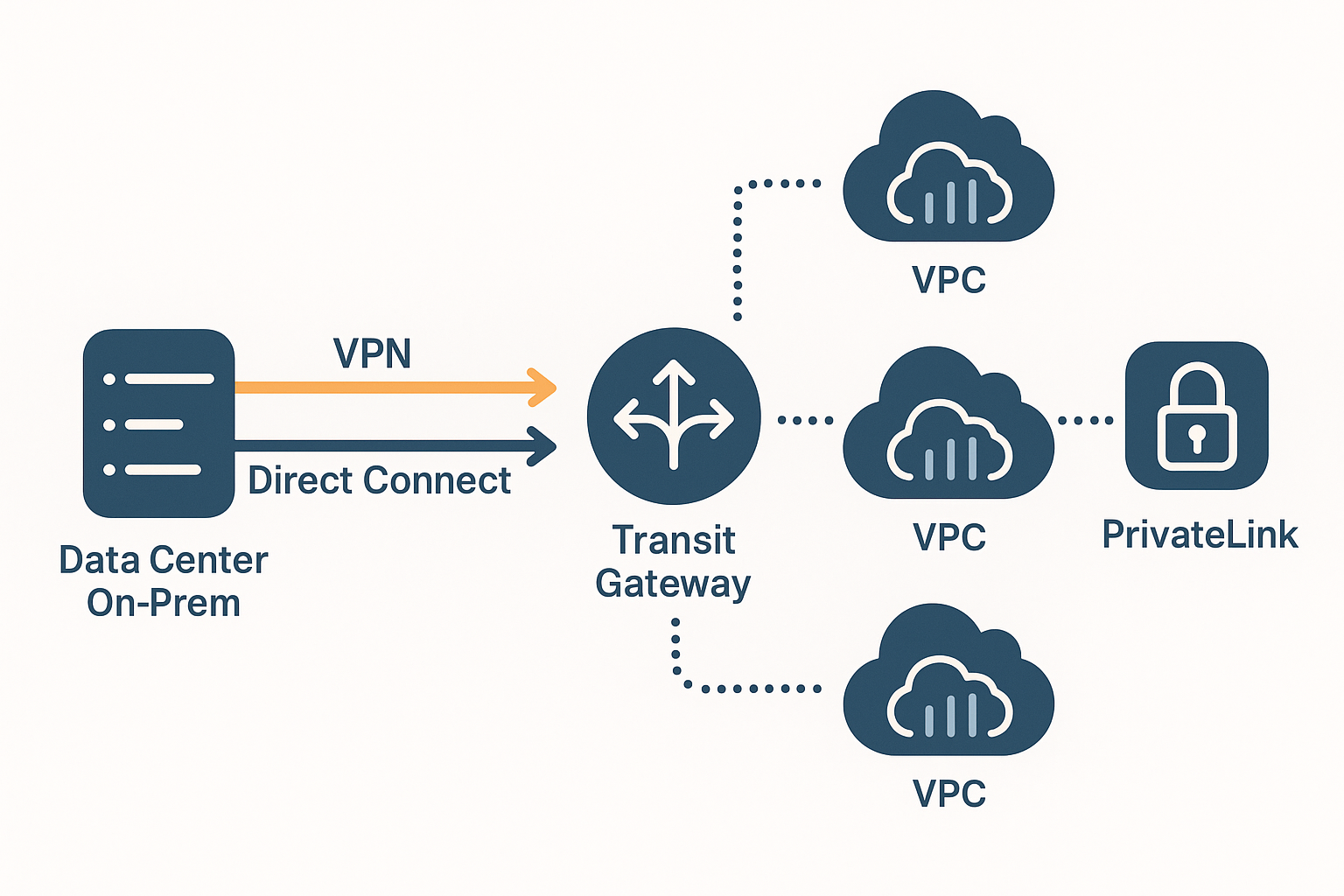VPN, Direct Connect, and Beyond: How to Design the Perfect Hybrid Connectivity


The Bridge Between Two Worlds
Every cloud architecture starts with a simple yet crucial question: how do I connect my world to the cloud?
In the traditional data center, everything lived under one roof: servers, storage, users, and applications. With AWS, the perimeter stretches across on-premises, multiple VPCs, and even multiple regions. Connectivity becomes the new glue of your infrastructure.
In AWS, this bridge can be built in several ways:
VPN: fast, flexible, cost-effective.
Direct Connect: stable, with consistent latency and predictable throughput.
A combination of both, orchestrated with Transit Gateway and, for service exposure, PrivateLink.
The point isn’t to pick a single road, but to understand when to use what to build a hybrid network that’s reliable, secure, and intelligent.

VPN: the Tunnel That Connects Different Worlds
A Virtual Private Network (VPN) is the quickest way to create a secure channel between your on-premises network and AWS—think of it as an encrypted tunnel across the public internet.
With AWS Site-to-Site VPN you get:
- IPsec with dual tunnels for high availability.
- Dynamic routing with BGP (or static if needed).
- Monitoring with Amazon CloudWatch (metrics, logs, alarms).
Note: Failover between tunnels is handled by BGP (or routing timers/metrics), not by CloudWatch.
When to use it
- Test/dev environments or temporary connections.
- Teams that want to start immediately without contracts or dedicated hardware.
- As a backup to a primary link.
Practical limits
- Throughput: up to ~1.25 Gbps per tunnel (also depends on your on-prem device and traffic profile).
- Latency/jitter: tied to the public internet (a one-lane bridge: it works, but quality isn’t guaranteed).
Useful option: Accelerated VPN
If the internet is “wobbly,” consider Accelerated Site-to-Site VPN, which leverages the AWS global network for more stable end-to-end routing.
Direct Connect: the Private Highway to the Cloud
When VPN isn’t enough, AWS Direct Connect (DX) comes into play: a dedicated physical connection between your data center and AWS.
Key benefits
- Consistently low latency: ideal for sensitive apps and large data transfers.
- Predictable throughput with less congestion: no public internet on the path.
- Predictable costs: pricing based on port and data transferred.
Security note: DX does not encrypt traffic by default. If you need encryption, one approach is to run a Site-to-Site VPN over Direct Connect (IPsec over DX) for end-to-end encryption.
DX + VPN: High-Performance Hybrid
Using Direct Connect as the primary route and VPN as backup is a well-proven pattern:
- DX provides stability and predictability.
- VPN kicks in automatically when the primary link is unavailable (failover via BGP/policy routing).
Alternatively, you can overlay VPN on DX to add encryption to the dedicated path.
Transit Gateway: the Traffic Director
If VPN and Direct Connect are the roads, AWS Transit Gateway (TGW) is the smart roundabout directing traffic among all networks:
- Centrally connects multiple VPCs, multiple accounts, and your on-prem links (via VPN or DX).
- Reduces routing complexity, avoiding a mesh of point-to-point peerings.
- Integrates with DX and VPN to route consistently across environments and regions.
In a typical hybrid design:
- Traffic reaches TGW via DX (or VPN).
- TGW applies the appropriate route tables.
- Traffic is distributed to the right VPCs, keeping the network scalable and easy to reason about.
Beyond: PrivateLink and Invisible Connectivity
The new frontier isn’t building more tunnels—it’s hiding them.
With AWS PrivateLink you can expose services privately within the AWS network, without public IPs, Internet Gateway, or NAT:
- Traffic flows through interface VPC endpoints.
- You drastically reduce external exposure.
- Ideal for multi-account architectures and SaaS models.
What PrivateLink is NOT
It’s not a network-to-network routing mechanism (that’s TGW or peering). PrivateLink is for consuming/exposing services privately.
The Ideal Hybrid Architecture

n a modern AWS environment, hybrid connectivity is layered:
- VPN for fast, flexible connections,
- Direct Connect for performance and stability,
- Transit Gateway to orchestrate everything,
- PrivateLink to make the network “invisible” yet connected.
It’s Not Enough to Connect—you Must Orchestrate
In 2010, “set up a VPN tunnel” might have been enough.
In 2025, the real challenge is orchestrating a hybrid network that’s resilient, observable, and automated.
Connectivity is no longer just a technical pipe—it’s a strategic component that determines the speed, security, and flexibility of your entire cloud ecosystem.
The question is no longer “How do I connect to AWS?”
but “How do I keep control of my network when everything is connected?”


